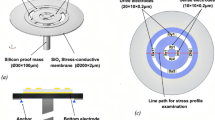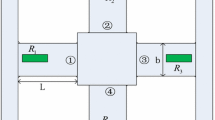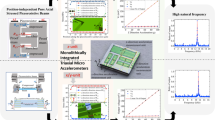Abstract
Purpose
The purpose of the designed MEMS dual axis accelerometer is to act as a seismic sensor by measuring low-level vibration at low frequencies, usually including those below 1 Hz. Piezoelectric materials have demonstrated broad applicability in numerous devices and electronic applications. Since piezoelectric energy harvesting devices create their highest power at the resonance frequency, there is a strong relationship between frequency and power density, where ω is the fundamental vibration mode frequency, the potential output power is proportional to 1/ω.
Methods
A dual-axis MEMS piezoelectric accelerometer for low-frequency seismic sensing was modelled and simulated with different suspension systems. For a bandwidth range of 1 KHz, COMSOL Multiphysics has been used to simulate the accelerometer supported by a U beam, Parallel beam, folded beam, and Swastik structures. The dual detection of acceleration in the X–Y direction and the ability to produce voltage was detected in all four variations of MEMS accelerometers.
Results
The dual detection of acceleration in the X–Y direction and the ability to produce voltage was detected in all four variations of MEMS accelerometers. Based on the investigation, it has been found that the Swastik design produces the highest stress overall, with a value of 0.4 × 105 N/m2 and has a maximum sensitivity of 0.8 × 10-3 Volts/g, making it more suited for seismic sensing applications.
Conclusion
The proposed dual-axis MEMS piezoelectric accelerometer with the Swastik suspension system can be used as a seismic sensor to detect low-frequency seismic signals, particularly P-waves. The findings of this paper can be applied in the development of new and improved MEMS accelerometers for various applications, such as vibration sensing, structural health monitoring, and seismic sensing.

















Similar content being viewed by others
References
Wu YM, Kanamori H (2008) Development of an earthquake early warning system using real-time strong motion signals. Sensors 8(1):1–9. https://doi.org/10.3390/s8010001
Chen D et al (2013) A micro electrochemical seismic sensor based on MEMS technologies. Sens Actuators A Phys 202:85–89. https://doi.org/10.1016/j.sna.2012.12.041
Hoque R, Hassan S, Sadaf MA, Galib A, Karim TF (2016) Earthquake monitoring and warning system. In: Proc. 2015 3rd int. conf. adv. electr. eng. ICAEE 2015, pp 109–112. https://doi.org/10.1109/ICAEE.2015.7506808
Kwon YW, Ahn JK, Lee J, Lee CH (2020) Earthquake early warning using low-cost MEMS sensors. In: Int. geosci. remote sens. symp., pp 6635–6637, 2020. https://doi.org/10.1109/IGARSS39084.2020.9323438
Cascone V, Boaga J, Cassiani G (2021) Small local earthquake detection using low-cost MEMS accelerometers: examples in Northern and Central Italy. Seism Rec 1(1):20–26. https://doi.org/10.1785/0320210007
Maria Dimova C, Stirk PMR (2019) Benefits of MEMS based seismic accelerometers for oil exploration, pp 9–25
Aizawa T, Kimura T, Matsuoka T, Takeda T, Asano Y (2008) Application of MEMS accelerometer to geophysics. Int J JCRM 4(2):1–4
Huang K et al (2021) A proposal for a high-sensitivity optical MEMS accelerometer with a double-mode modulation system. J Light Technol 39(1):303–309. https://doi.org/10.1109/JLT.2020.3023038
Scudero S, D’Alessandro A, Greco L, Vitale G (2018) MEMS technology in seismology: a short review. In: 2018 IEEE int. conf. environ. eng. EE 2018—proc., pp 1–5. https://doi.org/10.1109/EE1.2018.8385252
Mougenot D, Thorburn N (2004) MEMS-based 3C accelerometers for land seismic acquisition: Is it time? Lead Edge (Tulsa, OK) 23(3):246–250. https://doi.org/10.1190/1.1690897
Milligan DJ, Homeijer BD, Walmsley RG (2011) An ultra-low noise MEMS accelerometer for seismic imaging. Proc IEEE Sens. https://doi.org/10.1109/ICSENS.2011.6127185
Qu D, Cheng H, Liu D (2012) The influences of annealing temperature on the crystal phase and microstructure of the WO3 thin film. Adv Mater Res 562–564:7–10. https://doi.org/10.4028/www.scientific.net/AMR.562-564.7
Li C, Yang B, Zheng X, Sun Z, Zhou L (2022) A seismic-grade optical MEMS accelerometer with force feedback control. In: 29th Saint Petersbg. int. conf. integr. navig. syst. ICINS 2022, no 61874025, pp 1–8. https://doi.org/10.23919/ICINS51784.2022.9815378
Sun C, Tsai M, Liu Y, Fang W (2010) Implementation of a monolithic single. IEEE Trans Electron Devices 57(7):1670–1679
Mustafazade A et al (2020) A vibrating beam MEMS accelerometer for gravity and seismic measurements. Sci Rep 10(1):1–8. https://doi.org/10.1038/s41598-020-67046-x
Sobczyk M, Wiesenhütter S, Noennig JR, Wallmersperger T (2022) Smart materials in architecture for actuator and sensor applications: a review. J Intell Mater Syst Struct 33(3):379–399. https://doi.org/10.1177/1045389X211027954
Bera B, Das Sarkar M (2016) Piezoelectric effect, piezotronics and piezophototronics: a review. Imp J Interdiscipl Res (IJIR) 2(11):1407–1410
Lei YJ et al (2021) A high-precision two-dimensional micro-accelerometer for low-frequency and micro-vibrations. Precis Eng 67(August 2020):419–427. https://doi.org/10.1016/j.precisioneng.2020.10.011
Liu B et al (2020) A MEMS-based electrochemical angular accelerometer with integrated plane electrodes for seismic motion monitoring. IEEE Sens J 20(18):10469–10475. https://doi.org/10.1109/JSEN.2020.2993814
Chiang CT (2018) “Design of a CMOS MEMS accelerometer used in IoT devices for seismic detection. IEEE J Emerg Sel Top Circuits Syst 8(3):566–577. https://doi.org/10.1109/JETCAS.2018.2825604
Boom BA et al (2017) Nano-G accelerometer using geometric anti-springs. In: Proc. IEEE int. conf. micro electro mech. syst., vol 2, pp 33–36. https://doi.org/10.1109/MEMSYS.2017.7863332
Wang S, Zhu W, Shen Y, Ren J, Wei X (2020) In-plane dual-axis mems resonant accelerometer with a uniform sensitivity. In: Inert. 2020—7th IEEE int. symp. inert. sensors syst. proc., no 4, pp 8–11. https://doi.org/10.1109/INERTIAL48129.2020.9090093
Hui Xu M et al (2019) Design and fabrication of a D33-mode piezoelectric micro-accelerometer. Microsyst Technol 25(12):4465–4474. https://doi.org/10.1007/s00542-019-04495-z
Sthuthi A, Nithya G, Naveen Kumar K, Ramya SS (2023) Design and simulation of dual-axis MEMS accelerometer. Mater Today Proc. https://doi.org/10.1016/j.matpr.2023.05.569
Acknowledgements
The authors would like to thank the management of Nitte Meenakshi Institute of Technology, Bengaluru for setting up the Center for Nanomaterials and MEMS where this work was carried out.
Author information
Authors and Affiliations
Corresponding author
Additional information
Publisher's Note
Springer Nature remains neutral with regard to jurisdictional claims in published maps and institutional affiliations.
Rights and permissions
Springer Nature or its licensor (e.g. a society or other partner) holds exclusive rights to this article under a publishing agreement with the author(s) or other rightsholder(s); author self-archiving of the accepted manuscript version of this article is solely governed by the terms of such publishing agreement and applicable law.
About this article
Cite this article
Nithya, G., Sthuthi, A., Chandrashekar, N. et al. Modeling, Simulation, and Optimization of Piezoelectrically Actuated Dual-Axis MEMS Accelerometer for Seismic Sensing. J. Vib. Eng. Technol. 12, 5383–5395 (2024). https://doi.org/10.1007/s42417-023-01169-z
Received:
Revised:
Accepted:
Published:
Issue Date:
DOI: https://doi.org/10.1007/s42417-023-01169-z




